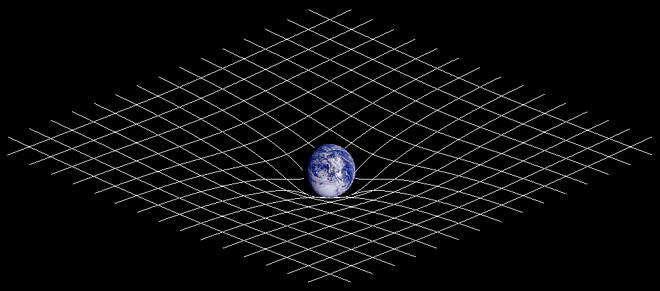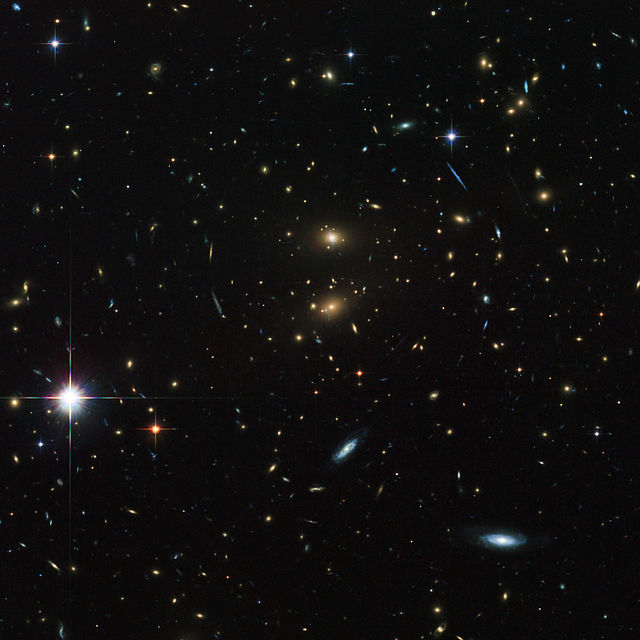Gravity
Article curated by Ed Trollope
The Theory of Gravity describes one of the most famous laws of physics. Mankind has known that things fall down since we were first able to think and we've had a scientific explanation for the existence of gravity for several hundred years, but surprisingly there are still more Things We Don't Know about gravity than physicists can shake an apple tree at.
Gravity is one of the few aspects of physics that is relevant at both the atomic and universal scales - and at both ends, there's something wrong.

What's Wrong with What We Know?
At very small distances (much smaller than even the size of an atom), the laws of gravity should match up with those of relativity, but they don't. Unfortunately, we lack the technology to conduct measurements or observations on such a tiny scale, but several branches of theoretical physics are looking for the answer.

At much larger distances such as those between the planets of our Solar System, our understanding of gravity is so good that we can launch spacecraft to land on other planets or visit asteroids and comets after journeys lasting many years. Yet, there is evidence that our model isn't perfect on the interplanetary scale, and spacecraft don't always behave quite the way we expect them to. In fact, astronomers are finding more problems than they can shake a telescope at.
When planning missions into deep space, spacecraft missions planners sometimes don't want to rely entirely on thrust from engines. The spacecraft can "fly by" a body like a planet or moon, and use the pull of gravity to change course and accelerate it on its way. Unfortunately for the mission planners, the outcome of these manoeuvres isn't always what they expect - sometimes, but not always, the final velocity is a little bit different.
The flyby anomaly was first spotted in Dec 1990, when the NASA Galileo spacecraft performed such a manoeuvre around the Earth, on its way to Jupiter. In 1998 the anomaly struck again, this time with the NASA NEAR Shoemaker spacecraft[2], and was seen a third time in 2005 by the European
Learn more about The Flyby Anomaly.


Of course, when planning a mission to another planet, it helps if you know where the other planet is - and how far your spacecraft will have to travel. Because of the large distances involved in space, rather than talking about hundreds of thousands of km, astronomers (and interplanetary spacecraft mission teams) typically use the Astronomical Unit (AU) instead. However in 2004, Russian scientists claimed that the AU was increasing by roughly 1.5cm each year, for unexplained reasons[3].

Let Me Play Among the Stars
Moving on to the distances between stars or even galaxies, even more holes appear in What We Think We Know. If two people link arms and spin around in a circle as fast as they can, they may find they're not strong enough and fly apart. Stars are no different, and the stars in a galaxy are spinning around and around, held together by the force of gravity. Strangely, the stars at the edges of galaxies are moving so fast that gravity shouldn't be strong enough to stop them flying away. The same is true of Galaxy Clusters, where entire galaxies appear to be held together by the influence of Dark Matter.
Learn more about Dark Matter.


While Dark Matter is a substance we cannot see, but whose gravitational effects we can detect, antimatter poses almost the opposite problem. Physicists have known about the existence of antimatter for almost a century, having been proposed in the presently understood form in a 1928 paper by Paul Dirac. These antiparticles have always been thought to possess almost all of the same basic properties as ordinary matter particles (other than a few things like charge), however some properties of antimatter, including the behaviour under gravity, have never been measured directly.
Researchers today are able to produce large quantities of Positronium - a bound state between an electron and a positron (the electron's antimatter equivalent) which decays rapidly in normal circumstances when the components annihilate. The short lifetime of these atoms makes their properties particularly difficult to study, however, and they need to be able to extend the lifetime of the positrons so they can determine the effect of gravity upon them. Being able to answer this question could provide interesting clues to other questions regarding the expansion of the universe and the difference between the quantities of matter and antimatter observed in the universe today.
Learn more about Properties of Antimatter.

 2
2With the intention of answering this question, astronomers have been using ever more powerful telescopes and techniques to perform increasingly accurate measurements of the rate at which the universe is expanding. The answer wasn't easy to find, as the rate of expansion is so close to the border between these two possible fates. The debate went on, until suddenly these efforts revealed something entirely unexpected: the universe's expansion isn't slowing down at all - it's actually getting faster.
Something must be pushing the universe apart, and we don't know what it is. Scientists do have some theories, but so far nothing matches what we can see.

 2
2
With the intention of answering this question, astronomers have been using ever more powerful telescopes and techniques to perform increasingly accurate measurements of the rate at which the universe is expanding. The answer wasn't easy to find, as the rate of expansion is so close to the border between these two possible fates. The debate went on, until suddenly these efforts revealed something entirely unexpected: the universe's expansion isn't slowing down at all - it's actually getting faster.
Something must be pushing the universe apart, and we don't know what it is. Scientists do have some theories, but so far nothing matches what we can see.

 2
2Black Holes
Perhaps the most mysterious subject of the gravitational mysteries is black holes. Although their existence is now well documented, what lies at the centre of a black hole? The most commonly stated answer would be a singularity - but is that really true?
A singularity is a point where a property is infinite. For black holes, this property is gravity. If one were to get pulled into a black hole, ignoring processes of spagettification (the process of being stretched out in a black hole due to the large gravity gradient - the force pulling on your feet is much stronger than that acting on your head) and other effects that would pull you apart before you got there, one would reach the centre of infinitely strong gravity and would become infinitely dense. It is at this point that Einstein’s theory of general relativity breaks down and physics stops working. Another example of a singularity is the Big Bang with infinite density and infinite temperature. However, singularities produce numerous paradoxes where the laws of physics seem to fail. Research into Loop Quantum Gravity and Loop Quantum Cosmology – a combination of quantum mechanics and general relativity – has come up with a method that explains some of the issues with applying Einstein’s theory of general relativity to singularities by suggesting that what we think of to be singularities are actually gateways into another Universe.
The research into Loop Quantum Gravity has considered the birth of the Universe and black holes. By simulating our Universe and ‘rewinding’ it, scientists from the Pennsylvania state university proposed that instead of the Universe collapsing back down into a singularity, it emerged from a super dense mass that may have had a history of its own, thus implying a ‘Big Bounce’ rather than a ‘Big Bang’ [8]. Other teams elsewhere applied Loop Quantum Gravity to a simple black hole and suggested that instead of a singularity, the information is somehow sent through to another Universe. This would solve one of the main paradoxes surrounding a black hole where the information that a black hole absorbs is destroyed on its evaporation thus defying the laws of physics. But it’s going to be a while before we know for sure.
Learn more about Do Singularities exist?.

 2
2The IceCube Neutrino Observatory is the largest neutrino telescope in the world, and in 2013 it detected 28 neutrinos that are believed to have come from outside of the Solar System[1].
Neutrinos only interact very weakly with matter, they pass straight through bodies such as the earth and they are also unaffected by gravity. Most neutrinos reaching the Earth originate from the sun or the Earth’s atmosphere, but some neutrinos (known as high-energy neutrinos) may originate from high energy cosmic events. As a result these neutrinos could be the perfect tool for gaining information on objects such as black holes and gamma-ray bursts.
Learn more about High-energy neutrinos.

 2
2What is the fabric of space?
Space contains everything we know, from the smallest atom to the biggest galaxy, yet we know little about the true nature of the fabric of space. Einstein's theory of General Relativity tells us that planets and stars are able to bend the fabric of space to produce gravity, yet we have no theory to tell us what it is made from, or even whats its fundamental properties are.
As with dark matter, we are limited in how much we can study the fabric of space by its transparency to everything we know. So far the only probe we have is gravity, which by its very nature tells us more about the mass of the planet or star than it does about space.

What is gravity, anyway?
According to the Standard Model, mass (and thus gravity) stems from the Higgs boson. Particles have mass because the Higgs boson 'sticks' to them. But this would imply that the bosons should also stick to each other, and get heavier and heavier - far heavier than the boson which was discovered at CERN, which is widely regarded to be the Higgs. So why don't Higgs particles stick together?
Learn more about Why don't Higgs particles stick together?.

All the fundamental forces of nature, apart from gravity, have been found to have associated elementary particles. Gravity is thought to also interact by a hypothetical elementary particle called the graviton. In order to fully prove the existence of gravitons they would need to be observed using a particle detector - but this is difficult to achieve because of the small scale at which gravitons are predicted to interact with matter, and the unfortunate fact that if gravitons were detected they would be indistinguishable from background neutrinos. For this reason there is not much current hope of answering the question "are gravitons real?" There is, however, a lot of promise in measuring gravitational waves.

Gravitational waves are ripples in the curvature of spacetime itself. They were detected for the first time by LIGO in 2015[4], and had previously been indirectly observed - their properties have been detected in binary pulsar systems (this won the Nobel Prize in Physics in 1993). There was quite some excitement in early 2014, when astronomers using the BICEP2 telescope at the South Pole announced that they had detected evidence of gravitational waves from the violent birth of the universe, but sadly the results were later dismissed as being merely a measurement of space dust instead[5]. In 2016, the researchers at LIGO published the results of another successful detection[6], believed to have been caused by the merging of two black holes. The detection and measurement of Gravitational Waves will open up a whole new world of astronomy, as they should permeate the universe which will allow us to probe eras which have previously been inaccessible, such as the early universe.
Learn more about Gravitational Waves.


According to New Scientist, the signal detected by LIGO was formed of three phases: the inspiral, the merger, and the ringdown. In the inspiral phase, the frequency of the gravitational waves of the black holes changes; and then when they merge, the signal increases in both intensity and frequency.
The ringdown phase is where the signal rapidly drops off, and if LIGO is sensitive enough to detect it, where the difference between a merged object being a black hole or some other exotic object
would become apparent. It is thought that the ringdown indicates the formation of an event horizon, as black holes are expected to be the only objects that will vibrate in this way. However, it might be possible for an object that is almost as compact as a black hole to vibrate in a similar way.
As stated in a paper by Cardoso, Franzin, and Pani, only precision observations of the late-time ringdown signal … can be used to rule out exotic alternatives to black holes
[7]. One alternative to a black hole suggested by these researchers is a “gravastar”, something which has not been observed before.
New Scientist describes a gravastar as a dense ball of matter kept inflated by a core of dark energy
. Instead of having an event horizon, gravastars can have a “light ring”, where photons are trapped in a circular orbit around the gravastar
.
Until precision observations of the ringdown signal are taken, we might not be entirely sure what the source of the gravitational waves LIGO detected was.


Even the speed of gravity is a matter of debate. We have several competing models of gravitation, and the speed of gravitational waves isn't the same in all of them. General relativity predicts that gravitational waves would travel at the same speed as light, and so far the experiments that have been done seem to support this - or at least, a speed very close to it. But those experiments are subject to controversy in themselves, so the question remains firmly unresolved.

Is Gravity a Fundamental Force?
Gravity is typically described as being a fundamental force of nature, but theoretical physicist and string theorist, Erik Verlinde, has claimed gravity may be an emergent phenomenon instead[9]. Gravity is often compared to other emergent phenomena, such as thermodynamics and hydrodynamics , because the laws of Gravity in many ways mathematically resemble those of thermodynamics and hydrodynamics. Scientists aren't usually big fans of coincidence, and this has led to considering the possibly there may be a link between gravity and thermodynamics.
If indeed a link between thermodynamics and gravity can be found, it could be a significant step towards the formation of a theory of everything - often considered the holy grail of theoretical physics.
Learn more about Gravity and Thermodynamics.

 2
2This article was written by the Things We Don’t Know editorial team, with contributions from DLR, Ed Trollope, Jim Sadler, Jon Cheyne, Cait Percy, Johanna Blee, and Alice Wayne.
This article was first published on 2015-08-27 and was last updated on 2018-01-05.
References
why don’t all references have links?
[1] IceCube Collaboration, (2013) Evidence for High-Energy Extraterrestrial Neutrinos at the IceCube Detector Science 342(6161):1242856 DOI: 10.1126/science.1242856
[2] P.G. Antreasian; J.R. Guinn (1998), "Investigations into the unexpected delta-v increase during the Earth Gravity Assist of GALILEO and NEAR", AIAA/AAS Astrodynamics Specialist Conf. and Exhibition, Boston, paper no. 98-4287
[3] Krasinsky, G. A.; Brumberg, V. A. (2004), "Secular increase of astronomical unit from analysis of the major planet motions, and its interpretation", Celest. Mech. Dynam. Astron. 90 (3–4): 363, arXiv:1108.5546, Bibcode:2011CeMDA.111..363F, doi:10.1007/s10569-011-9377-8
[4] Abbott, B., et al., (2016) Observation of Gravitational Waves from a Binary Black Hole Merger Physical Review Letters 116(6) DOI: 10.1103/PhysRevLett.116.061102
[5] Planck Collaboration Team (2014). "Planck intermediate results. XXX. The angular power spectrum of polarized dust emission at intermediate and high Galactic latitudes". ArXiv. arXiv:1409.5738.
[6] Abbott, B., et al., (2016) GW151226: Observation of Gravitational Waves from a 22-Solar-Mass Binary Black Hole Coalescence Physical Review Letters 116(24) DOI: 10.1103/PhysRevLett.116.241103
[7] Cardoso, V., Franzin, E., Pani, P., (2016) Is the Gravitational-Wave Ringdown a Probe of the Event Horizon? Physical Review Letters 116(17) DOI: 10.1103/PhysRevLett.116.171101
[8] Ashtekar, A., Pawlowski, T., Singh, P., (2006) Quantum Nature of the Big Bang Physical Review Letters 96(14) DOI: 10.1103/PhysRevLett.96.141301
[9] Verlinde, E., (2011) On the origin of gravity and the laws of Newton Journal of High Energy Physics 2011:29 DOI: 10.1007/JHEP04(2011)029
Blog posts about gravity





Recent gravity News
Get customised news updates on your homepage by subscribing to articles











